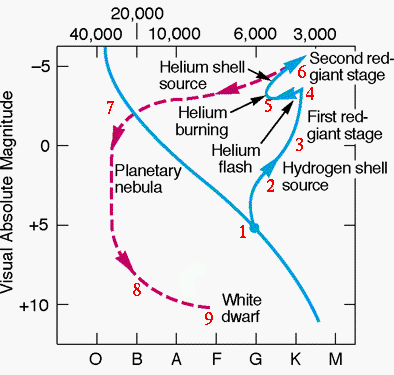 1) Our Sun is about 5 billion years old, and lies on the Main Sequence.
It started on the ZAMS, and has been slowly moving upward in
the HR diagram.
1) Our Sun is about 5 billion years old, and lies on the Main Sequence.
It started on the ZAMS, and has been slowly moving upward in
the HR diagram.
2) In 5 billion years, its core will have burned
90% of its Hydrogen and the Sun will leave the Main Sequence.
3) The Sun's core will collapse and heat up,
and expand to a Red Giant as it burns
a Hydrogen Shell, just outside its Helium ash
core. From the outside, the Sun will have grown
first physically larger AND then also cooler.
4) The central Helium core continues to collapse and
heat up. If it reaches temperatures of 100 Million K,
Helium fusion will ignite, beginning with the Helium
Flash.
5) Here, A Solar mass star will live almost a
billion years, while it fuses Helium in its core
via the triple alpha reaction
and Hydrogen in a thin shell outside the core.
6) As the Helium fuel runs out (leaving Carbon Ash),
and as the Hydrogen burning shell moves further out,
now a Helium shell begins to burn, but the star is
again moving to brighter and cooler as the star dies.
7) With time, the Sun's outer atmosphere, now extremely extended and
tenuous, will expand away and be seen as a Planetary Nebula.
8) As the outer atmosphere (Planetary Nebula) expands and thins
out, the hot, dense central carbon core is revealed.
This hot core is what we see as a White Dwarf.
9) White Dwarfs do not evolve. They slowly cool off, moving to
lower luminosity and lower temperature, as they slowly
radiate their energy away.